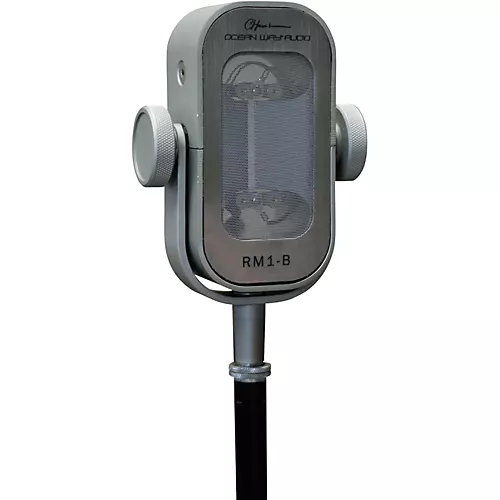Home
/
Ocean Way RM1-B Ribbon Microphone
Ocean Way RM1-B Ribbon Microphone
Quantity
-
DetailThe Ocean Way RM1-B microphone was designed, developed and engineered by pro-audio transducer inventor and technologist Cliff Henricksen. It was created to improve on well-known nuisance attributes of large-format ribbon microphones, namely low sensitivity (leading to a noisy processed signal), dull spectral output and difficult p-pop response. The RM1-B’s diaphragm is made from thin aluminum that vibrates in an intense magnetic field, creating unusually high output. The diaphragm's output is amplified by a carefully engineered and artistically voiced, low-noise phantom-powered preamplifier. This combination gives the user a true plug-and-play setup that rarely needs equalization, even in complex ensemble mixes. The Grill and Pop-Filter SystemA two-stage acoustically transparent, non-resonant debris and pop/plosives filter system prevents the usual artifact of close-proximity pickup for vocals and instruments. The first-stage is a non-metallic, non-resonant protective grille of tough, open-air, woven Nylon-Spandex. The second-stage is an internal sheer-knit acoustically transparent pop/debris filter that also improves close vocal applications and added ribbon protection. Beautiful Form and Exquisite FunctionAluminum case components are softened and matte-surfaced/softened as part of the manufacturing process and finished with an attractive but unassuming hard-anodize outer coating. The first-stage grille is stretched so that it exhibits a graceful geometric form and pleasing color. The aluminum case surrounds and protects the magnets, clamps the main grille and is an electromagnetic shield for the electronics. The knobs feel great and look right in proportion to the microphone. The softened, etched and anodized case components and knobs have a silky and friendly feel that invites the touch. The first-stage grille, although tough, has a refined, soft surface, especially compared to most metal-mesh grilles. In most cases, simple level adjustment is all that is required to make a beautiful recording of any voice or instrument. This microphone is superb for radio/TV broadcasting and for recording of many instruments including drums (NOT kick-drum), acoustic guitar, electric guitar amps, trumpets, trombones and much more. Its neutral appearance allows it to blend visually with any recording or visual broadcasting environment, looking beautiful without drawing attention to itself. High Signal Level A large-format corrugated diaphragm made of pure aluminum measuring 2 in. x 0.160 in. x 0.00007 in. is almost buoyant in free air, making it sensitive and responsive to changes in sound pressure. Its size and geometry give well-known output benefits of high mechanical velocity. An extremely powerful magnetic circuit results in an unprecedented 1Tesla gap-flux intensity level at and around the ribbon. This combination gives at least a 6dB boost in at-the-ribbon level compared to similar microphones. A zero-feeback, all-discrete preamplifier works off standard 48v phantom power and delivers a solid mic-level signal with very low noise. All amplification is done at the ribbon, inside the microphone, allowing the RM1-B to deliver a true differential signal at a level that often requires very little upstream amplification (the kind of gain that makes the most noise). Magnetic Boundaries Create HF-Capture GainBoundaries of the magnetic circuit are physically-shaped to both make efficient use of the monster NeO magnetic energy and (as you'll read in this section) to improve the capture of high frequencies above 6 KHz. This design detail creates improvements in sensitivity, capture of sibilance-detail and a more defined off-axis polar response in both directions.Pickup Pattern of the RM1-BIn many ways the RM1-B picks up sound like any classic bidirectional large-format ribbon microphone. In the horizontal plane, full-fidelity pickup is achieved on-axis in both the front and rear of the microphone. This allows the microphone to be used in many unique ways from instrument/voice recordings to multiple voice recordings to a unique integration of direct sound and ambient sound. The RM1-B's high frequency pattern, however, is unique among bidirectional microphones. Because of the shape of the magnetic circuit in the vicinity of the ribbon, the pickup pattern becomes determined by the geometry of the sloping walls of the iron magnetic conductors. This more selective pickup actually improves the ribbon's sensitivity and makes for a "tighter" HF sound in the upper two octaves, in both directions.
-
Customer ReviewsNo comments

 Fender
Fender Gibson
Gibson Taylor
Taylor Martin
Martin lbanez
lbanez Epiphone
Epiphone PRS
PRS Schecter Guitar Research
Schecter Guitar Research Fender Stratocaster
Fender Stratocaster Fender Telecaster
Fender Telecaster Gibson Les Paul
Gibson Les Paul Gibson SG
Gibson SG lbanez RG
lbanez RG Taylor American Dream
Taylor American Dream Taylor GS Mini
Taylor GS Mini Martin GPC
Martin GPC lbanez
lbanez Fender
Fender Squier
Squier Ernie Ball Music Man
Ernie Ball Music Man Sterling by Music Man
Sterling by Music Man Rickenbacker
Rickenbacker Sire
Sire Schecter Guitar Research
Schecter Guitar Research Fender Precision Bass
Fender Precision Bass Fender Jazz Bass
Fender Jazz Bass Fender Mustang
Fender Mustang lbanez SR
lbanez SR Strandberg Boden
Strandberg Boden Yamaha TRBX
Yamaha TRBX Yamaha BB
Yamaha BB Schecter Stiletto
Schecter Stiletto Fender
Fender Marshall
Marshall Orange Amplifiers
Orange Amplifiers Markbass
Markbass Boss
Boss Blackstar
Blackstar Kemper
Kemper Vox
Vox Line 6
Line 6 Electro-Harmonix
Electro-Harmonix MXR
MXR Meris
Meris Dunlop
Dunlop EarthQuaker Devices
EarthQuaker Devices lbanez
lbanez TC Electronic
TC Electronic Alesis
Alesis Roland
Roland Zildjian
Zildjian DW
DW Simmons
Simmons Meinl
Meinl Remo
Remo TAMA
TAMA Pearl
Pearl Vic Firth
Vic Firth Sound Percussion Labs
Sound Percussion Labs Evans
Evans Sabian
Sabian Lp
Lp Yamaha
Yamaha Yamaha
Yamaha Roland
Roland Korg
Korg Williams
Williams Akai Professiona
Akai Professiona Casio
Casio Nord
Nord Moog
Moog Williams Legato
Williams Legato Yamaha Clavinova
Yamaha Clavinova Harbinger
Harbinger Bose
Bose JBL
JBL Electro-Voice
Electro-Voice Behringer
Behringer Yamaha
Yamaha Mackie
Mackie JBL EON
JBL EON Bose L1 Pro
Bose L1 Pro QSC K Series
QSC K Series Yamaha Mixers
Yamaha Mixers Harbinger VAR!
Harbinger VAR! Focusrite
Focusrite Universal Audio
Universal Audio Yamaha
Yamaha PreSonus
PreSonus Tascam
Tascam KRK
KRK Rode
Rode Focusrite Scarlett
Focusrite Scarlett Universal Audio Apollo
Universal Audio Apollo Shure
Shure Sennheiser
Sennheiser AKG
AKG Neumann
Neumann Rode
Rode Sterling Audio
Sterling Audio Audio-Technica
Audio-Technica Warm Audio
Warm Audio AKG 414
AKG 414 Musician Geal
Musician Geal Fender
Fender D'Addario
D'Addario Ernie Ball
Ernie Ball Elixir
Elixir Road Runner
Road Runner Gator
Gator Proline
Proline Remo
Remo Livewire
Livewire On-Stage
On-Stage Hercules
Hercules Mogami
Mogami Dunlop
Dunlop Perri's
Perri's Snark
Snark
